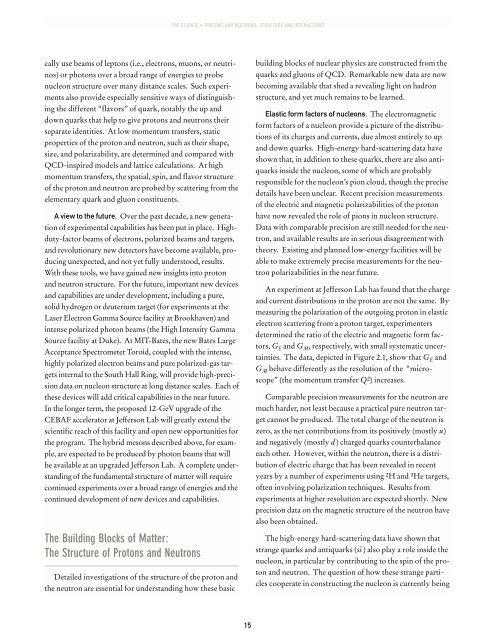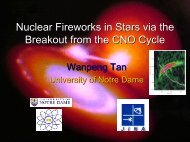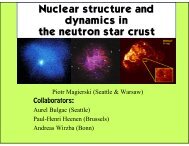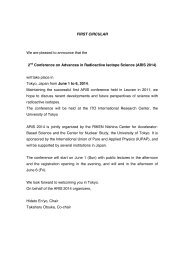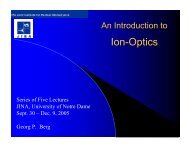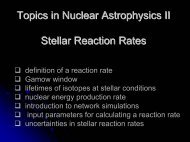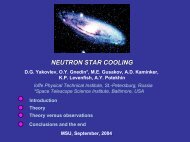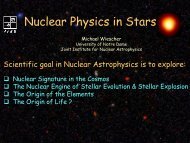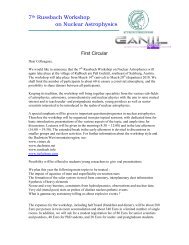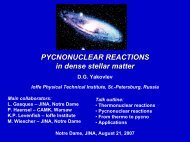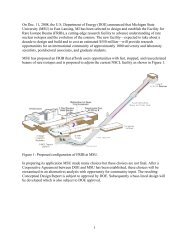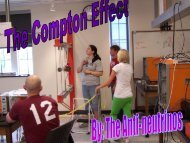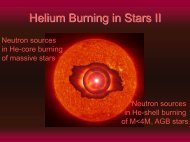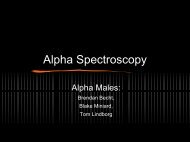OPPORTUNITIES IN NUCLEAR SCIENCE A Long-Range Plan for ...
OPPORTUNITIES IN NUCLEAR SCIENCE A Long-Range Plan for ...
OPPORTUNITIES IN NUCLEAR SCIENCE A Long-Range Plan for ...
You also want an ePaper? Increase the reach of your titles
YUMPU automatically turns print PDFs into web optimized ePapers that Google loves.
THE <strong>SCIENCE</strong> • PROTONS AND NEUTRONS: STRUCTURE AND <strong>IN</strong>TERACTIONS<br />
cally use beams of leptons (i.e., electrons, muons, or neutrinos)<br />
or photons over a broad range of energies to probe<br />
nucleon structure over many distance scales. Such experiments<br />
also provide especially sensitive ways of distinguishing<br />
the different “flavors” of quark, notably the up and<br />
down quarks that help to give protons and neutrons their<br />
separate identities. At low momentum transfers, static<br />
properties of the proton and neutron, such as their shape,<br />
size, and polarizability, are determined and compared with<br />
QCD-inspired models and lattice calculations. At high<br />
momentum transfers, the spatial, spin, and flavor structure<br />
of the proton and neutron are probed by scattering from the<br />
elementary quark and gluon constituents.<br />
A view to the future. Over the past decade, a new generation<br />
of experimental capabilities has been put in place. Highduty-factor<br />
beams of electrons, polarized beams and targets,<br />
and revolutionary new detectors have become available, producing<br />
unexpected, and not yet fully understood, results.<br />
With these tools, we have gained new insights into proton<br />
and neutron structure. For the future, important new devices<br />
and capabilities are under development, including a pure,<br />
solid hydrogen or deuterium target (<strong>for</strong> experiments at the<br />
Laser Electron Gamma Source facility at Brookhaven) and<br />
intense polarized photon beams (the High Intensity Gamma<br />
Source facility at Duke). At MIT-Bates, the new Bates Large<br />
Acceptance Spectrometer Toroid, coupled with the intense,<br />
highly polarized electron beams and pure polarized-gas targets<br />
internal to the South Hall Ring, will provide high-precision<br />
data on nucleon structure at long distance scales. Each of<br />
these devices will add critical capabilities in the near future.<br />
In the longer term, the proposed 12-GeV upgrade of the<br />
CEBAF accelerator at Jefferson Lab will greatly extend the<br />
scientific reach of this facility and open new opportunities <strong>for</strong><br />
the program. The hybrid mesons described above, <strong>for</strong> example,<br />
are expected to be produced by photon beams that will<br />
be available at an upgraded Jefferson Lab. A complete understanding<br />
of the fundamental structure of matter will require<br />
continued experiments over a broad range of energies and the<br />
continued development of new devices and capabilities.<br />
The Building Blocks of Matter:<br />
The Structure of Protons and Neutrons<br />
Detailed investigations of the structure of the proton and<br />
the neutron are essential <strong>for</strong> understanding how these basic<br />
building blocks of nuclear physics are constructed from the<br />
quarks and gluons of QCD. Remarkable new data are now<br />
becoming available that shed a revealing light on hadron<br />
structure, and yet much remains to be learned.<br />
Elastic <strong>for</strong>m factors of nucleons. The electromagnetic<br />
<strong>for</strong>m factors of a nucleon provide a picture of the distributions<br />
of its charges and currents, due almost entirely to up<br />
and down quarks. High-energy hard-scattering data have<br />
shown that, in addition to these quarks, there are also antiquarks<br />
inside the nucleon, some of which are probably<br />
responsible <strong>for</strong> the nucleon’s pion cloud, though the precise<br />
details have been unclear. Recent precision measurements<br />
of the electric and magnetic polarizabilities of the proton<br />
have now revealed the role of pions in nucleon structure.<br />
Data with comparable precision are still needed <strong>for</strong> the neutron,<br />
and available results are in serious disagreement with<br />
theory. Existing and planned low-energy facilities will be<br />
able to make extremely precise measurements <strong>for</strong> the neutron<br />
polarizabilities in the near future.<br />
An experiment at Jefferson Lab has found that the charge<br />
and current distributions in the proton are not the same. By<br />
measuring the polarization of the outgoing proton in elastic<br />
electron scattering from a proton target, experimenters<br />
determined the ratio of the electric and magnetic <strong>for</strong>m factors,<br />
G E and G M , respectively, with small systematic uncertainties.<br />
The data, depicted in Figure 2.1, show that G E and<br />
G M behave differently as the resolution of the “microscope”<br />
(the momentum transfer Q 2 ) increases.<br />
Comparable precision measurements <strong>for</strong> the neutron are<br />
much harder, not least because a practical pure neutron target<br />
cannot be produced. The total charge of the neutron is<br />
zero, as the net contributions from its positively (mostly u)<br />
and negatively (mostly d) charged quarks counterbalance<br />
each other. However, within the neutron, there is a distribution<br />
of electric charge that has been revealed in recent<br />
years by a number of experiments using 2 H and 3 He targets,<br />
often involving polarization techniques. Results from<br />
experiments at higher resolution are expected shortly. New<br />
precision data on the magnetic structure of the neutron have<br />
also been obtained.<br />
The high-energy hard-scattering data have shown that<br />
strange quarks and antiquarks (ss - ) also play a role inside the<br />
nucleon, in particular by contributing to the spin of the proton<br />
and neutron. The question of how these strange particles<br />
cooperate in constructing the nucleon is currently being<br />
15


